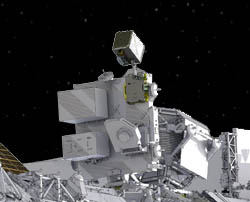
The Neutron star Interior Composition ExploreR
(NICER) is an NASA experiment placed on the International Space Station (ISS).
NICER observe the sky in the X-ary band (0.2-12 keV) with large collective area and
fine time resolution. It was launched on a SpaceX Falcon 9 rocket on June 3, 2017,
and commenced operations on June 14. The mission was approved for 18 months of
operations that was extended in March 2019 and is still operating.
Mission Characteristics
 Lifetime
Lifetime : June 14, 2017–present (as of Oct 2020)
 Energy Range
Energy Range : 0.2–12 keV
 Special Features
Special Features : Concentrator optics with high
temporaral and moderate spectral resolution.
 Payload
Payload :
- X-ray Timing Instrumen (XTI) consists of 56 concentrator
optics, providing a 5 arcmin non-imaging field of view onto a matching set
of silicon drift detectors (SSDs).
- Energy range; 0.2- 12 keV
- Energy Resolution : 85 eV at 1 keV; 137 eV at 6 keV
- Effective area : >2000 cm2 at 1.5 keV
- Time resolution : 300ns
 Science Highlights
Science Highlights:
- Demonstration of Station Explorer for X-ray Timing and Navigation Technology (SEXTANT) using pulsar timing to provide navigation
- Investigate extreme gravity, density and magnetic fields found in neutron stars
- Measure neutron stars radius and mass with increased accuracy
 Archive
Archive : HEASARC hosts the NICER data.